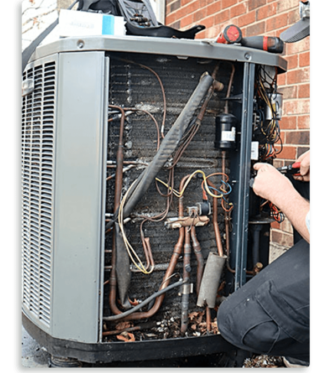Comfort in our homes and workplaces is often taken for granted, but the silent player behind that comfort is the HVAC system. At the core of this system is something even more overlooked: the ductwork. As the arteries of an HVAC, ducts play a pivotal role in how we heat or cool our spaces. Let’s dive into the intricacies of HVAC ductwork.
Basics of HVAC Ductwork
HVAC ductwork is a series of channels designed to distribute airflow from your HVAC system throughout your building or home. Common materials used for ductwork include galvanized steel and aluminum. Sometimes, ducts might be made of materials like fiberglass for enhanced flexibility. Ducts generally come in two types: flexible ducts and rigid ducts.
Flexible Ducts
As their name suggests, flexible ducts are a type of ductwork characterized by their malleability and versatility. Constructed primarily from a spiraled wire coil wrapped in a flexible plastic outer layer, these ducts can easily snake around obstacles, making them ideal for complex spaces where rigid ducts would be difficult or impossible to install.
However, while their adaptability makes them a favorite in some HVAC installations, flexible ducts come with a few caveats. The ducts lack durability and can become compressed, which can severely impact airflow and the overall efficiency of the HVAC system. Proper installation is crucial to prevent sagging or sharp bends, which can compromise the system’s performance.
Rigid Ducts
Rigid ducts are a primary choice in many HVAC installations due to their durability and efficiency in maintaining the desired temperature of conditioned air. These ducts are typically constructed from sheet metal, such as galvanized steel or aluminum, which gives them rigidity. This solid construction means the ducts are less susceptible to tears or punctures compared to their flexible counterparts. Moreover, the smooth inner surfaces of rigid ducts offer less resistance to airflow, ensuring optimal efficiency and consistent distribution of conditioned air throughout a building. This makes them ideal for longer duct runs where maintaining air pressure and minimizing heat loss or gain is crucial.
However, installing rigid ducts requires a higher level of expertise due to the need for precise measurements and custom fittings, especially when navigating around obstacles or conforming to specific architectural features. While rigid ducts can be insulated externally to reduce heat loss or gain, it’s essential to ensure that the insulation is correctly applied to prevent condensation, which can lead to mold growth or reduced system efficiency. Despite these challenges, the longevity and performance of these ducts make them a favored choice if you’re seeking a long-term solution.
Anatomy of a Ductwork System
Air Handlers and Blowers
Often perceived as the heart of the HVAC system, air handlers and blowers are responsible for the actual movement of air through the ducts. These components house the fans that create the necessary pressure differential, causing air to flow. They ensure consistent, forceful propulsion of conditioned air through the supply ducts and facilitate the suction of “stale” air via the return ducts. The efficiency and power of these blowers can significantly impact the HVAC system’s capability to heat or cool a space rapidly.
Supply Ducts
At the heart of the ductwork system are the supply ducts, the extensive network of tubes responsible for distributing conditioned air—whether heated or cooled—from the HVAC unit to the various rooms or zones in a building. These channels extend outwards from the central unit, reaching even the furthest corners. Their primary role is to ensure that the conditioned air is evenly and efficiently delivered throughout the space. Their diameter, length, and layout are crucial factors that can influence the overall efficiency of the system, as they dictate the velocity and volume of air distribution.
Return Ducts
Complementing the supply ducts are the return ducts, which serve as the system’s “respiratory tract.” After the conditioned air has been released into a room and has naturally mixed with the ambient environment, it needs to be recirculated back to the HVAC unit for reconditioning. This is where the return ducts come in. They ensure that the HVAC system receives a continuous flow of air, which helps in maintaining a balanced atmospheric pressure within the enclosed space, thereby maximizing the efficiency of the heating or cooling process.
Registers and Grilles
While these components might seem merely decorative, registers and grilles play a pivotal role in directing and managing airflow. Positioned at the endpoints of ducts, they essentially act as the “nozzle” through which air enters or leaves a room. Registers, in particular, come equipped with dampers or adjustable slats. These dampers allow users to control the volume and direction of airflow, ensuring optimal distribution and comfort. Grilles, on the other hand, primarily prevent larger objects from entering the duct system, though they can sometimes be adjusted to control airflow direction.
Dampers
Dampers act as the “valves” of the ductwork system, regulating and directing the flow of air within the ducts. Installed at various intersections and branches of the ductwork, they can be adjusted manually or automatically to increase or decrease airflow to specific zones or rooms. This allows for precise control over the heating or cooling in different areas, ensuring that each space gets just the right amount of conditioned air. In more advanced HVAC systems, automated dampers can adjust in real-time based on the input from thermostats or sensors, optimizing energy use.
Air Filters
Positioned typically at points where air enters the HVAC system, especially at the return ducts, air filters act as sieves, trapping particles and preventing them from circulating back into the living or working spaces. There are several types of air filters, each designed to capture different sizes and types of particulates.
The efficiency of an air filter is usually measured by its minimum efficiency reporting value (MERV) rating. A higher MERV rating indicates finer filtration, capable of trapping smaller particles. For residential applications, filters with MERV ratings between 8 and 13 are standard, whereas industrial and healthcare settings might require filters with ratings between 16-20 for enhanced air purity.
The Importance of Ductwork Design
Ductwork design serves as the blueprint for any HVAC system, guiding the distribution of conditioned air throughout a structure. Its significance cannot be overstated, as the design determines the overall efficiency of the system and, consequently, the comfort levels within a space. Properly sized and strategically placed ducts ensure that each room receives a balanced airflow, eliminating problematic hot or cold spots arising from suboptimal design.
Moreover, the ductwork layout holds substantial financial implications. An efficient design, with minimal bends and optimized duct sizing, minimizes resistance to airflow, ensuring the HVAC system operates at peak efficiency. This optimal operation directly translates to reduced energy consumption, resulting in lower utility bills. On the other hand, a poorly designed duct system can lead to energy losses, uneven temperature distribution, and, over time, increased wear and tear on the HVAC unit due to overcompensation.
Get in Touch With HVAC Professionals Today!
Are you in Northern California and need reliable HVAC services? Look no further! We specialize in a range of air quality services, from ductwork installation to air duct cleaning and carbon monoxide detection. Moreover, we proudly offer comprehensive plumbing, heating, and cooling solutions. Whether it’s water heaters, heat pumps, or AC installation and repair, we’ve got you covered. Call Environmental Heating & Air Solutions today to learn more about our services!

